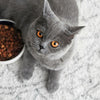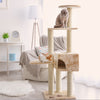How to Make Your Cat Lose Weight?
- by Rufus and Coco
More than half of owned cats in the world are overweight or obese. And because excess weight can lead to a variety of health complications, you should make it a priority to help your cat lose a pound or two should the need arise.
In today’s article, we list down some practical ways to help your kitty shed unwanted pounds.
5 Tips on Weight Loss for Cats
Slow and steady wins the race
Weight loss isn't something that happens overnight and it can be a long and gradual process depending on how overweight your pet is. Even if your cat is severely overweight, making it starve definitely isn't healthy.
When a cat doesn’t get enough food in their system, their body is forced to use more of the energy stored as fat. While this process can inevitably lead to weight loss, it can be detrimental. When your cat’s body relies on fat deposits to produce energy, there are some compounds, called ketone bodies, that are produced as a result. These bodies that accumulate in your cat’s system are toxic and have to be released through the urinary pathway making extreme and fast weight loss put your cat’s kidney health in danger.
Just like in humans, the slow and steady route is the healthier and more sustainable option.
Exercise
Nothing beats exercising as a way of losing weight healthily. The trouble with cats these days, especially those that live exclusively indoors, is that they cannot get the same amount of exercise as their outdoor counterparts. On one hand, they can be healthier in the sense that they don’t come in contact with other animals from which they could catch diseases from. But on the other hand, this can lead them to seek other entertainment opportunities. And when there is none, they’ll reach out for the food bowl just to pass the time. And even if they don't resort to eating excessively, a sedentary lifestyle is almost as equally bad.
Your cat’s living space should be as entertaining as possible. Ideally, they should have an area where they lounge, but also a playground packed with cat trees and toys.
When you get back from work, you should set aside some playtime. Daily play sessions are essential for your cat’s mental and physical health, so try to spend at least 30 minutes doing it.
The Fling & Chase Cat Toy or the Rechargeable Laser Cat Toy can help your pet get in the ‘play’ mood even if they are otherwise inclined. All cats dream of catching that tiny dot, so you aren’t going to have a hard time convincing your own to get more exercise in this way.
Try a different diet
Cat food these days come in many varieties, and they are made for different purposes. Many are tailored to the specific needs of certain pets, whether they have kidney or liver issues, or whether they just have to lose some weight.
Without a doubt, low-calorie cat food is less appealing taste-wise. But that’s the main point. Because the food is less appetising, they will be less likely to reach for the food bowl whenever they get bored.
Switching your pet to a low-calorie diet can be challenging at first. In fact, it would be best if you do it gradually. Cats rarely respond well to sudden diet changes. Even if they don’t have anything against the taste of the new food, they might still experience some symptoms, such as mild digestive distress, just because their bodies aren’t used to the new diet.
Avoid free-feeding
Free-feeding is one of the main reasons why cats become obese or overweight. You have no control over how much your cat eats when you are away from home unless you use solutions such as home cameras or an automatic feeder.
Controlling the amount of dry cat food that your pet indulges in when you aren’t present is one of the best ways of solving the problem.
In the wild, cats are not supposed to have food available all the time. If they manage to hunt down something and they have a meal, that will typically be enough for the whole day.
You can give your cat a canned variety in the morning before you leave, and while you’re at work, you can rely on your automatic feeder to make sure that your cat doesn’t overeat. Once you’re back home, you can give another meal consisting of wet food. Canned brands are almost always better to give to cats due to their water content. Cats aren't known for their drinking habits so it's a way of making sure they don’t become dehydrated.
Change your cat’s routine
As previously mentioned, cats do not respond well to new and significant changes. However, you can gradually get your cat accustomed to them being fed at specific times in a day.
You can also make things more interesting by rewarding them with new toys (and hiding the older ones for two-three weeks until they forget a bit about them).
Make your cat get used to the idea that every evening, there’s fun to be had. If they know that you’ll be back with them and give them plenty of attention while also helping them have fun, they’ll look forward to the time they spend with you every day.
Does your cat need to lose weight?
There are more than enough online resources that can help you tell if your cat has a normal weight or if they should shed a few pounds. However, do keep in mind that every pet is different, and some breeds are simply larger because of their characteristics.
Comparing the size and weight of a Maine Coon and Munchkin can be quite shocking. These two are not supposed to have the same weight, even if they were to have the same age.
Ask your vet whether your cat’s weight is normal as per specific health requirements and other factors. Your veterinarian is also the right person to consult if you’re looking for additional ways of making your pet lose some weight as they can recommend the appropriate diet for your cat.
Sources:
Ketone bodies - An Overview, P.A.C. McPherson, 2016 https://www.sciencedirect.com/science/article/pii/B9780123849472004086
Factors associated with overweight cats successfully completing a diet-based weight loss programme: an observational study, Erin M. O’Connell et al, 2018 https://www.ncbi.nlm.nih.gov/pmc/articles/PMC6295068/
- Posted in:
- cat
- health-tips
- how to help
- tips







